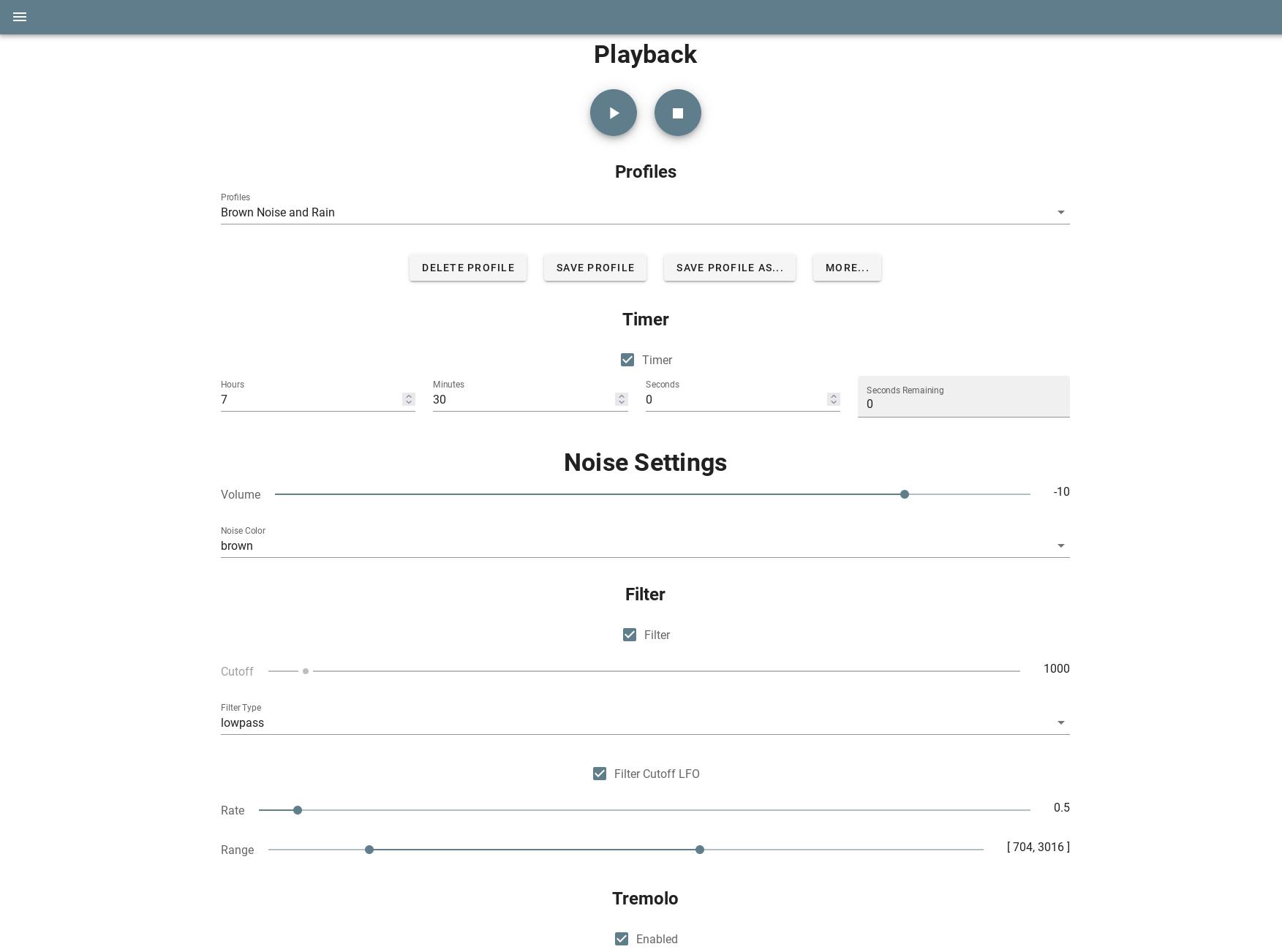Ecosyste.ms: Awesome
An open API service indexing awesome lists of open source software.
https://github.com/kaythomas0/noisedash
Self-hostable web tool for generating ambient noises
https://github.com/kaythomas0/noisedash
ambient ambient-noise audio javascript node self-hosted vue vuetify web-audio
Last synced: about 2 months ago
JSON representation
Self-hostable web tool for generating ambient noises
- Host: GitHub
- URL: https://github.com/kaythomas0/noisedash
- Owner: kaythomas0
- License: agpl-3.0
- Created: 2021-07-17T21:16:47.000Z (almost 3 years ago)
- Default Branch: dev
- Last Pushed: 2024-01-11T04:55:36.000Z (5 months ago)
- Last Synced: 2024-01-25T11:40:31.383Z (4 months ago)
- Topics: ambient, ambient-noise, audio, javascript, node, self-hosted, vue, vuetify, web-audio
- Language: JavaScript
- Homepage:
- Size: 3.22 MB
- Stars: 256
- Watchers: 3
- Forks: 16
- Open Issues: 3
-
Metadata Files:
- Readme: README.md
- Contributing: CONTRIBUTING.md
- Funding: .github/FUNDING.yml
- License: LICENSE
Lists
- awesome-selfhosted - Noisedash - Self-hostable web tool for generating ambient noises/sounds using audio tools and user-uploadable samples. `AGPL-3.0` `Nodejs/Docker` (Software / Miscellaneous)
- awesome_AF - Noisedash - Self-hostable web tool for generating ambient noises/sounds using audio tools and user-uploadable samples. `AGPL-3.0` `Nodejs` (Software / Miscellaneous)
- awesome-starred - kaythomas0/noisedash - Self-hostable web tool for generating ambient noises (vue)
- fucking-awesome-selfhosted - Noisedash - Self-hostable web tool for generating ambient noises/sounds using audio tools and user-uploadable samples. `AGPL-3.0` `Nodejs/Docker` (Software / Miscellaneous)
- awesome-selfhosted - Noisedash - Self-hostable web tool for generating ambient noises/sounds using audio tools and user-uploadable samples. `AGPL-3.0` `Nodejs/Docker` (Software / Miscellaneous)
README
# Noisedash
Self-hostable web tool for generating ambient noises

(More screenshots on the [wiki](https://github.com/kaythomas0/noisedash/wiki/Screenshots))
# Features
* Generate and customize ambient noises and user-uploadable samples (leveraging [Tone.js](https://github.com/Tonejs/Tone.js/))
* Save "noise profiles" so you can easily switch between your created soundscapes. Import and export them for easy sharing, record them for use elsewhere
* Fine-tune your noises with audio processing tools like filters, LFOs, and effects
* Upload and edit audio samples (e.g rain, wind, thunder) to combine with your generated noises. Add effects to them and set playback modes
* Use admin tools to manage multiple users
* Mobile friendly
# Installation
## Docker
Requires docker and docker-compose
* Download the provided [docker-compose.yml file](https://github.com/kaythomas0/noisedash/blob/main/docker-compose.yml)
* In the same directory as the docker-compose file, created a folder called `config`, and inside it, put the provided [config file](https://github.com/kaythomas0/noisedash/blob/main/config/default.json)
* Edit the config file to your preference
* Bring the container up:
``` bash
docker-compose up -d
```
* Proceed to the URL where it's deployed and register your first user
(Raspberry Pi compatible images are available, see armv7 images on [Docker Hub](https://hub.docker.com/repository/docker/noisedash/noisedash))
## Kubernetes
You can apply the manifest.yaml in the kubernetes folder to install Noisedash into your Kubernetes cluster.
Optionally, uncomment the last lines in the file to also create an ingress. The ingress, commented out by default, needs to have the clusterIssuser annotation set to your cluster issuer (default: letsencrypt-prod) and the ingress class set to your Ingress class (default: Nginx)
``` bash
$ kubectl apply -f ./kubernetes/manifest.yaml
persistentvolumeclaim/db-pvc created
persistentvolumeclaim/samples-pvc created
deployment.apps/noisedash created
service/noisedash created
configmap/noisedashcfg created
ingress.networking.k8s.io/noisedashingress created
```
## From Source
Requires node 16 and npm
* Clone the repo:
``` bash
git clone https://github.com/kaythomas0/noisedash.git
cd noisedash
```
* Edit `config/default.json` to your preference
* Install required packages and build the app:
``` bash
npm install
NODE_ENV=production npm run build
```
* The build files will be put into a directory called `dist`
* Run the server and serve static files:
``` bash
npm run server-prod
```
* Proceed to the URL where it's deployed and register your first user
# Contributing
See [CONTRIBUTING.md](https://github.com/kaythomas0/noisedash/blob/main/CONTRIBUTING.md)
# License
Noisedash, a self-hostable web tool for generating ambient noises
Copyright (C) 2021 Kay Thomas
This program is free software: you can redistribute it and/or modify
it under the terms of the GNU Affero General Public License as published
by the Free Software Foundation, either version 3 of the License, or
(at your option) any later version.
This program is distributed in the hope that it will be useful,
but WITHOUT ANY WARRANTY; without even the implied warranty of
MERCHANTABILITY or FITNESS FOR A PARTICULAR PURPOSE. See the
GNU Affero General Public License for more details.
You should have received a copy of the GNU Affero General Public License
along with this program. If not, see .